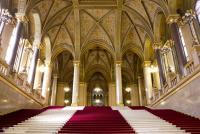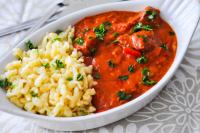
Hospitality, rich history and traditions, Turkish spas, Lake Balaton, Rubik’s Cube, gipsy music, Pálinka, Goulash, paprika, Ferenc Puskás - this is how a foreigner illustrate this beautiful country where international students and lecturers are very welcome. It’s not an easy task to summarise Hungary’s main features and characteristics as more than 1100 years has passed since its foundation and during this long period a unique culture has developed. Hungary, after several historical eras and events of the XXth century (the Austrian-Hungarian Monarchy, the Revolution of ’56, the socialist regime during 40 years and the change of eras in 1989), joined the European Union the 1st of May 2004 and since then became an indispensable part of the European integration and mobility

From a more cultural view, Magyarország (the original name of the country) has a lot of peculiar traditions, such as the Busó Festival in Mohács or the habit of sprinkling girls at Easter. Several craft won international reputation, the Kalocsai Folk Art patterns became famous after Lewis Hamilton and Jenson Button Formula 1 drivers wore these patterns on their overalls. Several places located in Hungary belong to the World Heritage like the Tokaj Wine Region, the Buda Castle, Hortobágy National Park or the Early Christian Necropolis of Pécs.

The gastronomy of Hungary encourage visitors to come back to the country, and not only dishes like Goulash gained international reputation but other Hungaricums like Túró Rudi, Pick salami, Unicum or different types of pálinka as well. Budapest is also well-known for its wine and gastronomy festivals and its ruin pubs situated in the oldest district of the capital providing a specific atmoshpere to the visitors (not to mention Europe’s biggest festival, Sziget).
Hungarians are an extraordinary creative and talented nation proved by many worldwide-known inventions like the ballpoint pen, the holography, the dynamo, the safety match, the first nuclear reactor and so many other technical tools which make easier our everyday life.
Sport is very popular in Hungary, but not just as a freetime activity. Hungarians are also known for their achievements in sports, first of all in waterpolo, swimming, canoe and kayak, handball, penthatlon and fencing. At the total medal count for Olympic games, almost every four years Hungary forms part of the ten best ranked countries.
There are hundreds of worldwide famous Hungarians like Ferenc Puskás football player, Ferenc Liszt or Béla Bartók composers, Albert Szentgyörgyi inventor of vitamin C, Tony Curtis and Béla Lugosi (known for his role as Dracula) actors, Harry Houdini illusionist, Imre Kertész (Nobel Prize-winning author), and last but not least Robert Capa war photographer.
More information: https://gotohungary.com/about-hungary
Facts and figures
Area: 93 036 km2
Population: 9 942 000
Official language: Hungarian (Magyar)
Religion: 54.5% Roman Catholic, 21% Reformed (Calvinist) Protestant
Capital: Budapest
Currency: Hungarian Forint (HUF)
Governance: parliamentary democracy
Time zone: Central European Time (GMT+1)
Telephone country code: +36
Climate: continental; average temperature: summer 25 °C (77 °F), winter -5 °C (23 °F)
Membership in international organisations: NATO (1999), EU (2004), OECD (1996), Schengen Agreement